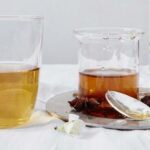 Yes, Champagne’s a great way to start any evening’s gastronomic activities. But I, on a warm summer’s night, in the gathering twilight, on the verandah, wearing my crisply pressed white dinner jacket, chatting with Noel Coward about cricket, reach far more often for a gin & tonic, surely one of the most refreshing, palate-opening cocktails ever invented.
Yes, Champagne’s a great way to start any evening’s gastronomic activities. But I, on a warm summer’s night, in the gathering twilight, on the verandah, wearing my crisply pressed white dinner jacket, chatting with Noel Coward about cricket, reach far more often for a gin & tonic, surely one of the most refreshing, palate-opening cocktails ever invented.
Problem is, the state of gin-and-tonic-making is at perilously low levels. Whenever I order one (well, usually without a white dinner jacket, and usually discussing the Mets with some guys from Queens), some combination of the following problems crops up:
*too much gin
*not enough gin
*gin that’s too strong
*tonic that’s flavorless
*tonic that’s flat
*too much ice
*too little ice
*too little lime
So I got to work, attempting once and for all to standardize all that I love about G&T-ness. Here are the secrets:
1) The drink works best with a gin that’s light, low in alcohol—otherwise the drink is bitter and hot. I recently compared the alcohol levels of gins on the market, and was amazed to find a range from 41.2% alcohol up to almost 50% alcohol! The one that was 41.2% is Plymouth Gin, one of the lightest, loveliest gins you can buy, bursting with flavor (its recipe using juniper berries, coriander seeds, citrus peel and angelica root was first made in 1793), and certainly my favorite for the gin & tonic. It was a favorite of such luminaries as Ian Fleming (did Bond drink G&Ts?), Winston Churchill and FDR. The latter consumed it at Campobello because it used to be available in the American market, but has been off for decades—until its re-introduction this year. That’s big news! I say grab it now, by all means, for the best G&T you’ve ever had.
2) The drink works best with the right tonic water—which is to say water that’s very lively/bubbly, and water that has much of the traditional quinine flavor. There are a number of tonic waters widely available but, for my money, the out-and-out leader in the field—the only one I’ll use—is Schweppes. I like to buy it in small bottles so that it remains unopened and fresh; if you’re buying large bottles, make sure you can use most of it right after you open it.
3) Lastly, the biggest secret of all: take your Schweppes water and pour it into an ice cube tray! A few hours later, your Tonic Ice Cubes will provide you with the tightest tasting, most integrated G&T you can imagine—with no watery meltdown as your conversation with Noel gets heated.
The Frosty Plymouth Gin & Tonic
makes one gin & tonic
four Schweppes Tonic Water Ice Cubes (see NOTE)
3 ounces Plymouth Gin
4 ounces Schweppes Tonic Water
1 tablespoon freshly squeezed lime juice
lime wedge for garnish
1. Place the ice cubes in a tall, narrow, chilled glass (the cubes should come near the top.) Add the gin, then the tonic water, then the lime juice, stirring well. Garnish with lime wedge, and serve immediately. White dinner jacket is optional.
NOTE: To make the ice cubes, simply fill an empty ice cube tray with Schweppes Tonic Water, and let the cubes freeze. It takes just a few hours. Covered well, the cubes will remain fresh tasting in the freezer for at least a few weeks.


